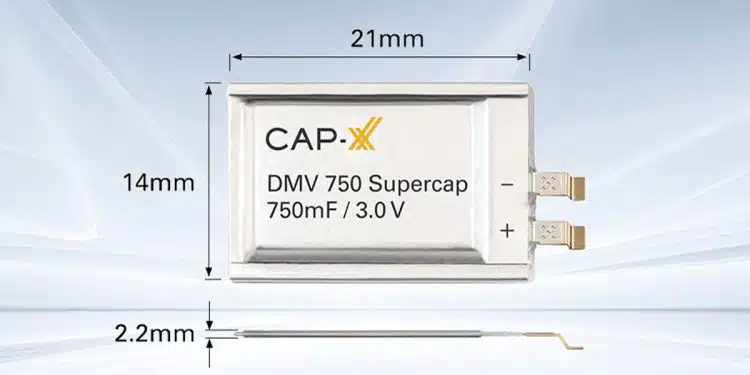CAP-XX, the leading manufacturer of ultra-thin prismatic, cylindrical, and Lithium-Ion supercapacitors, has launched its DMV750 ultra-thin 2.2mm prismatic 3V 750mF supercapacitor to provide high performance for IoT, medical and other space-constrained and mission-critical electronic devices.
The 3V ultra-thin prismatic supercapacitor packs 23% more energy than a same-size 2.7V supercapacitor, and can complement 3V coin cell batteries, replace bulky 3V cylindrical supercapacitors to save space, or replace batteries using energy harvesting to charge sustainable battery-less devices or more battery-efficient applications. It measures 21 millimetres x 14 millimetres x 2.2 millimetres, and operates from -20°C to +85°C.
This multi-purpose 3V prismatic supercapacitor can support the industry’s common 3V coin cell battery to extend its life and functionality, replace a bulky 3V cylindrical supercapacitors to save design space, or replace batteries altogether when micro energy harvesting can extract enough solar, vibration, RF or other environmental energy to charge the ultra-efficient supercapacitor in sustainable battery-less devices.
“It is estimated that over 5 billion 3V coin cell batteries and 12 billion IoT devices are sold annually,” explained Anthony Kongats, CEO at CAP-XX. “While not all devices will require a supercapacitor, a large number would benefit from using our powerful DMV750 supercapacitor to store and release the energy needed for peak power functions like data transmission.”
Kongats continued, “Our DMV750 ultra-thin prismatic 3V supercapacitor provides design engineers with multiple options to overcome power delivery challenges in space-constrained, mission-critical and sustainable electronic devices.”
3-Volt DMV750 Applications:
- Energy harvesting for remote wireless sensors, wireless HVAC sensors and actuators
- Asset tracking
- RTC and memory backup power
- Peak load shaving when configured in parallel with a 3V coin cell battery (CR2032 for example)






























